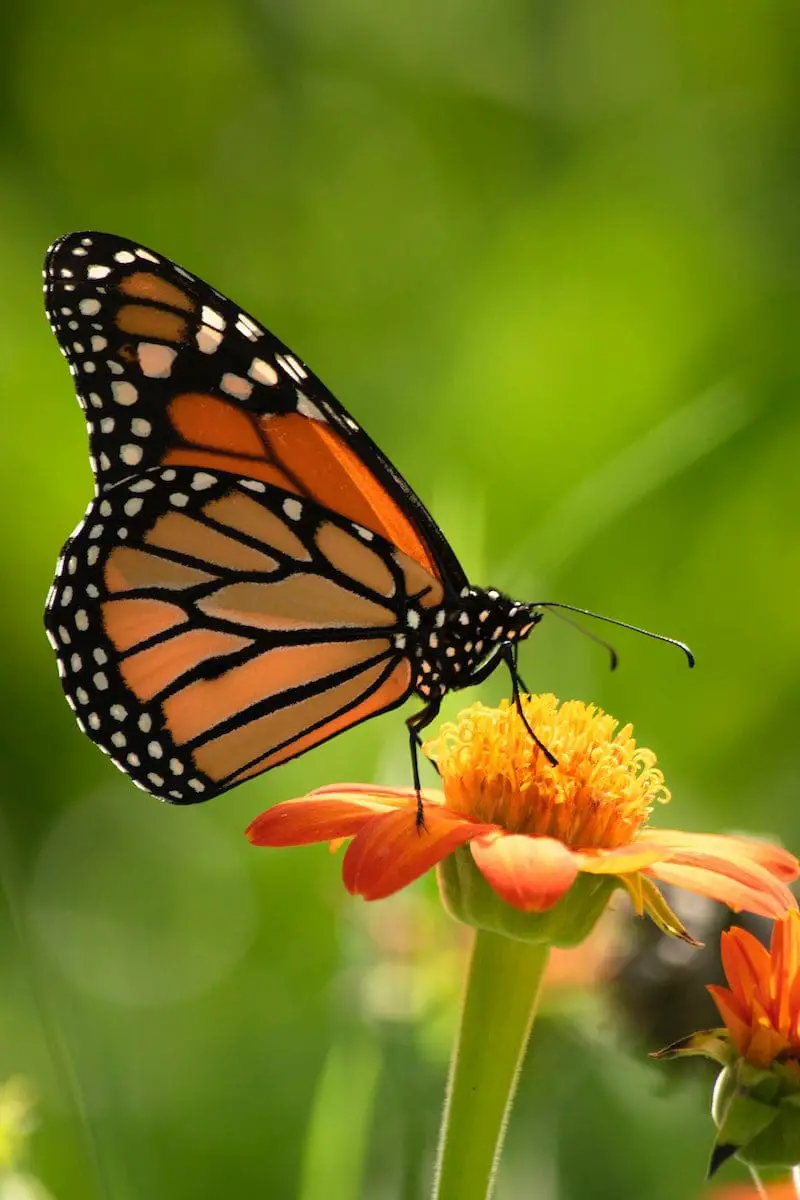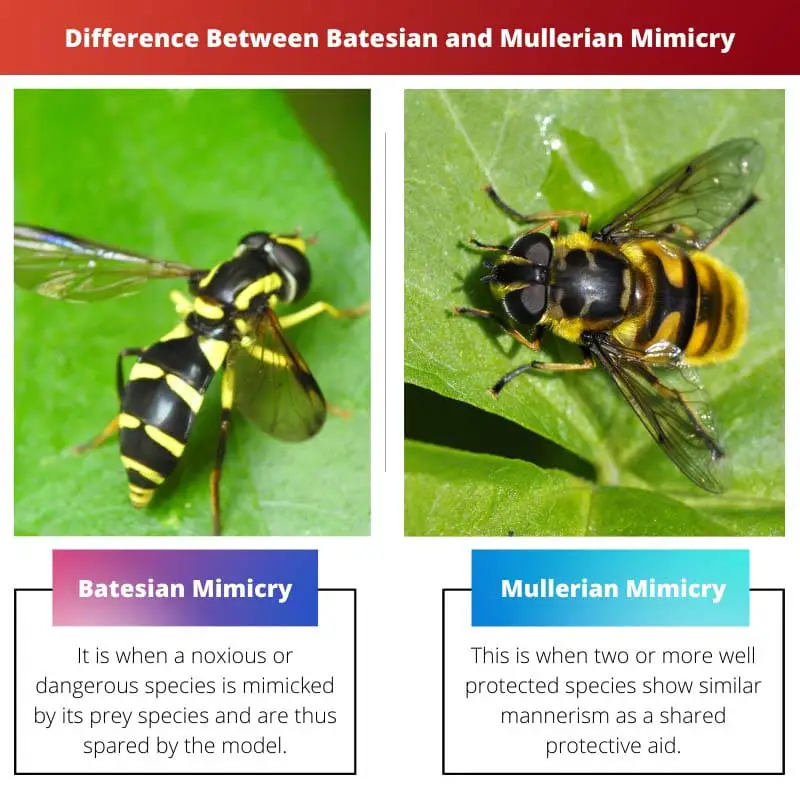The most basic rule of the world is Survival of the fittest. All species adapt in different ways to survive in this world. Many animals have been observed to practice mimicry to escape their predators.
Batesian and Mullerian mimicry are two types of survival methods observed in nature.
Key Takeaways
- Batesian Mimicry is a type of Mimicry where a harmless species mimics the appearance of a dangerous or poisonous species.
- Mullerian Mimicry is a type of Mimicry where two or more dangerous or poisonous species evolve to share the same warning signals.
- While Batesian Mimicry benefits the mimicking species, Mullerian Mimicry benefits all the species involved, as predators learn to avoid them all.
Batesian vs Mullerian Mimicry
The difference between the two types of mimicry is that Batesian is one harmless species adopting the looks or characteristics of a harmful species to stay protected. In contrast, Mullerian mimicry is when similar species showcase similar characteristics to avoid their predators.

When a harmless species evolves itself to showcase characteristics of another harmful species to confuse its predator and hence stay protected.
The unprotected prey species: also called mimics, gain protection from predators by mimicking their warning calls, looks, patterns of skins, and more. This is a very classic example of evolution by natural selection.
Similarly, when two or more well-defended species share common predators, they mimic each other’s honest warning calls for mutual benefits. It is called Mullerian mimicry.
These species are foul-tasting and inedible. Warning signals are for the predators to notice them and be warned that they are inedible and unrelated species. Having similar signals prevents predators from hunting them too. For example, similar colour patterns.
Comparison Table
| Parameters of Comparison | Batesian | Mullerian |
|---|---|---|
| Definition | It is when a noxious or dangerous species is mimicked by its prey species and are thus spared by the model. | This is when two or more well-protected species show similar mannerisms as a shared protective aid. |
| Type of mimic animal | Harmless animals showcase it. | Dangerous animals showcase it. |
| Type of relationship | It is a type of parasitic relationship. | It is a type of mutualistic relationship. |
| Benefactor | The mimic is the benefactor in this case. | The mimic and model are both the benefactors in this case. |
| Abundance of species | The model should be abundant in the area. | The model and mimic should be abundant in the area. |
What is Batesian Mimicry?
Batesian mimicry is when harmless prey mimics its predator to stay protected. It is named after English naturalist Henry Walter Bates. The prey or the mimic mimics its predator or the model.
The model considering the mimic as one of its leaves it alone, and thus the mimic prevents being hunted.
This is a case of defensive mimicry. The mimicry includes but is not limited to the visual aid. It encompasses auditory signals and polymorphism.
Sometimes, prey (mimic) may adopt characteristics of aposematic animals(model) to make them look distasteful purposely.
This form of mimicry avoids any confrontation between the mimic and the model.
For example, some tiger moths are aposematic by sound and are mimicked by pyralid moths; even though they aren’t foul-tasting, they emit similar sounds.
The success of this method widely depends on how dangerous the model is and its abundance in the area due to frequency-dependent selection.
The form of Batesian mimicry where the mimic doesn’t exactly copy the model is called imperfect Batesian mimicry.
A fly species known as Spilomyia longicornis mimics vespid wasps. The fly doesn’t have antennas like the wasps, so they put their front legs over their heads to make them look like the antennas of the wasp.

What is Mullerian Mimicry?
Mullerian mimicry is when two unrelated species adopt similar characteristics for protection from predators. This concept was first proposed by German zoologist Fritz Muller.
This phenomenon was initially received with general skepticism. All predators first sample their prey before learning the lesson that they are inedible.
They stop hunting animals that look similar to the first one. Other unrelated species evolve to have a similar colour or pattern as the predators have learned to avoid them.
There is, however, a disadvantage to this method as there is a loss when the predator makes the initial contact and learns the lesson.
One life will always be lost to teach the other species a lesson. But other species that copy them do not have to make that sacrifice and are thus well protected.
One of the most common examples of this mimicry is seen in butterflies.
Different butterflies adopt similar wings and colour patterns, so the predators cannot distinguish between the edible and non-edible species and thus avoid them.
It is not necessary for mimicry to virtual. Many-a-times, snakes use similar auditory signals to avoid being recognized by predators.

Main Differences Between Batesian and Mullerian Mimicry
The main difference between the two types is that Batesian is a harmless species mimicking its predator. In contrast, Mullerian mimicry is two similar species exhibiting similar characteristics to share the loss incurred during initial contact. Other differences are:
- Batesian is a parasitic relationship, and only the mimic benefits, whereas Mullerian is a mutualistic relationship, and both the mimic and model benefit.
- Batesian requires the model to exist in abundance, whereas, in Mullerian, the model and mimic may exist in equal abundance.
- Less dangerous animals exhibit Batesian. On the other hand, Mullerian mimicry is exhibited by well-protected species.
- The success of Batesian mimicry depends on accurately deceitful the mimic can be, which is not precisely the case for Mullerian mimicry.
- Even though the two concepts sound similar, Batesian was proposed by Henry Bates and Mullerian was proposed by Fritz Muller.

- https://academic.oup.com/biolinnean/article-abstract/13/1/1/2682689
- https://onlinelibrary.wiley.com/doi/abs/10.1111/j.0014-3820.2004.tb01708.x

The concept of Batesian and Mullerian mimicry is quite thought-provoking. It’s an interesting look at the natural world’s strategies for survival.
Indeed, it’s amazing how these methods have evolved over time to protect different species.
Absolutely, nature is full of fascinating mechanisms for survival.
While it’s interesting to learn about these mimicry methods, it’s unfortunate that there’s a loss of life involved in the process of predators learning to avoid certain species.
That’s a valid point. Nature can be brutal, even in its survival strategies.
The way harmless species can mimic dangerous ones for their own protection is truly remarkable. It’s an example of evolution’s incredible work.
Absolutely, the adaptability of these species is something to be admired.
It’s intriguing to learn about Batesian and Mullerian mimicry and how they have evolved as methods of protection for various species.
Agreed, the complexities of these mimicry methods are truly captivating.
Definitely, it’s a fascinating glimpse into the world of natural survival strategies.
It’s interesting to note the difference in the relationship between the mimic and model in Batesian and Mullerian mimicry. These survival methods are truly unique.
Definitely, the mutualistic relationship in Mullerian mimicry is a particularly fascinating aspect.
A fascinating look at how nature has developed these methods of protection. It’s amazing to see the different ways species have evolved to survive.
I completely agree, nature never ceases to amaze with its strategies for survival.
Batesian and Mullerian mimicry are two fascinating survival methods. It’s impressive to see how species adapt to their environments.
Agreed, it showcases the incredible complexity and diversity of nature.
The concept of Batesian mimicry, named after Henry Walter Bates, is a testament to the incredible ways in which species have adapted for survival.
Absolutely, it’s a testament to the ingenuity of natural selection in the animal kingdom.
While the methods of Batesian and Mullerian mimicry are impressive, it’s unfortunate that there’s a disadvantage to the Mullerian method due to the initial predator contact.
Indeed, there’s always a balance of advantages and disadvantages in these natural mechanisms.
That’s an interesting point, nature’s survival strategies are complex and not without their drawbacks.
The comparison between Batesian and Mullerian mimicry is quite enlightening. Nature’s ingenuity is truly on display in these mechanisms.
Absolutely, the complexity of these survival methods is remarkable.